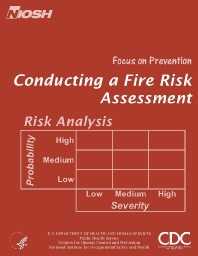Mining Product: Focus on Prevention: Conducting a Fire Risk Assessment
Original creation date: October 1999
The first step to emergency preparedness is defining and analyzing hazards. Although all hazards should be addressed, resource limitations usually do not allow this to happen all at once. Risk assessments are used to establish priorities so that the most dangerous situations are addressed first and those least likely to occur and least likely to cause major problems can be considered later. While the examples provided in this training package are specific to mine fires, the concepts and tools can be applied to any mine hazard.
This training package outlines a group activity. During this session trainees will: 1) learn about risk assessment concepts and tools and 2) conduct a risk assessment of their work environment. The guide outlines six steps to completion of a fire risk assessment and provides two forms that can be used to document the process. References for additional information are included. Conducting this activity with groups of workers on-site would result in the identification and prioritization of fire safety hazards. This would lead increased effectiveness in fire prevention and response planning.
Skills reviewed: fire hazard identification, risk analysis, fire prevention
Duration: 20+ minutes
Materials included in file download:
- Instructor Copy
Authors: LG Mallett, MJ Brnich
Audience: Any group of workers familiar with the location(s) being studied.
NIOSH/USBM Numbered Publication - October 1999
NIOSHTIC2 Number: 20000547
U.S. Department of Health and Human Services, Public Health Service, Centers for Disease Control and Prevention, National Institute for Occupational Safety and Health, DHHS (NIOSH) Publication No. 99-155, 1999 Oct :1-6
See Also
- Detection of Downed Trolley Lines Using Arc Signature Analysis
- Determining the Root Causes of Flame Cutting and Welding Fires in Underground U.S. Coal Mines
- Effectiveness of Various Concentrations of an Inert Gas Mixture for Preventing and Suppressing Mining Equipment Cab Fires: Development of a Dual-Cab Fire Inerting System
- Emergency Escape and Refuge Alternatives
- A Fail-Safe Control System for a Mine Methane Pipeline
- Innovative Strategies for Mine Fire Preparedness
- Major Hazard Risk Assessment Applied to Pillar Recovery Operations
- Mapping Hazards with Microseismic Technology to Anticipate Roof Falls - A Case Study
- Refuge Chamber Expectations Training - 1.0
- Using Major Hazard Risk Assessment to Appraise and Manage Escapeway Instability Issues: A Case Study
- Content source: National Institute for Occupational Safety and Health, Mining Program


 ShareCompartir
ShareCompartir
